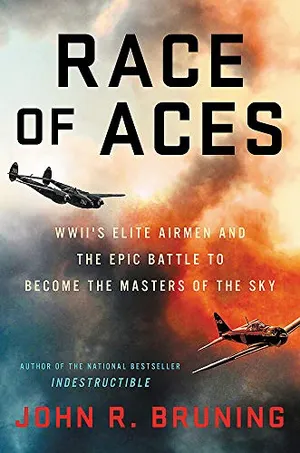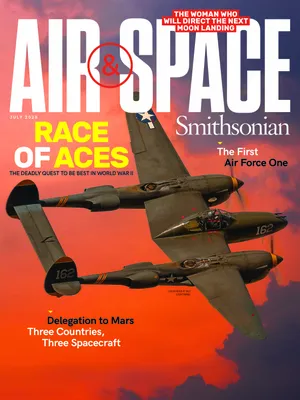For World War II Pilots, the Race to Be an Ace Sometimes Turned Deadly
When the line between duty and ambition began to blur.
:focal(1071x366:1072x367)/https://tf-cmsv2-smithsonianmag-media.s3.amazonaws.com/filer/8a/ba/8abab4ba-7df4-4e22-bb6a-f438bc2ce834/13i_jj2020_usaf_live.jpg)
When General George Kenney assumed command of the Fifth Air Force in July 1942, he inherited, as he would later write, “a hell of a mess.” In the southwest Pacific Theater, working aircraft—and parts and fuel—were hard to come by. The Fifth’s primary pursuit plane, the Bell P-39 Airacobra, was no match for the Japanese Zero. Fortunately, Kenney knew that a solution to his problem would soon arrive: the Lockheed P-38 Lightning.
To boost morale, Kenney had World War I ace Eddie Rickenbacker—who was in the southwest Pacific at the request of the Secretary of War—give his men a pep talk. As Rickenbacker regaled them with tales of fighting von Richthofen’s Flying Circus in 1918, Kenney had an inspiration. He challenged the pilots of the Fifth Air Force to beat Rickenbacker’s score of 26 kills. The dare would lead to one of the most closely followed stories in the wartime press: the race of aces.
Race of Aces: WWII's Elite Airmen and the Epic Battle to Become the Master of the Sky
The astonishing untold story of the WWII airmen who risked it all in the deadly race to become the greatest American fighter pilot.
In 1942, the Fifth Air Force was a ragtag, beaten force that the Japanese crushed and ran out of the Philippines, then crushed and ran out of the Dutch East Indies. The same was happening in New Guinea. But by 1944, after two years of fighting, Allied airpower controlled the sea-lanes into New Guinea, and the Japanese were unable to support their troops on the island. Japanese air units in New Guinea were on their last legs, making fewer appearances.
General Douglas MacArthur wanted to end the New Guinea campaign as soon as possible; his original plan envisioned a careful jump to Southern Mindanao in the Philippines, well covered by the fighter units based at Morotai and Biak. But instead of Mindanao, MacArthur’s troops invaded Leyte in the middle of the archipelago. The Navy covered the landings, as the island lay beyond P-38 range. After a week of furious air-sea battles that saw the first use of kamikaze aircraft, the Navy couldn’t remain on station defending the Leyte beachhead indefinitely.
A handful of pilots were sent to the half-built airstrip at Tacloban, a tiny toehold on the northeast corner of Leyte, surrounded by Japanese-held islands and 200 enemy airfields. The pilots’ task was to defend the airstrip and the cargo ships offloading supplies, and help the troops fighting their way inland whenever possible.
Each night, Japanese raiders struck the airstrip; the Americans dashed from their tents to slit trenches to spend hours in mud-filled holes. Engineers worked from 0800 to midnight trying to improve the runway. They’d been able to add several hundred feet of Marston matting [perforated steel planking, named for the North Carolina town where it was first used], but the constant rain turned the rest of the airfield into such a mess that operation accidents were getting out of hand.
/https://tf-cmsv2-smithsonianmag-media.s3.amazonaws.com/filer/5a/1d/5a1d4678-6421-404a-a89e-3ebc8c8e3548/13e_jj2020_475thfgassn03_live.jpg)
Among the pilots was the Fifth Air Force’s highest-scoring ace, Second Lieutenant Richard Ira Bong, of Poplar, Wisconsin—population 300. His fellow pilots found him almost invisible. But his farm-boy persona vanished in the P-38 cockpit. The straight arrow became a wild man: unpredictable, intuitive, liberated. No longer the introvert, he became ferociously aggressive.
Also at Tacloban was the Fifth’s second highest-scoring ace: Major Tommy McGuire, a New Jersey native raised in the Deep South. McGuire didn’t fit in; he was defensive, prickly, and developed a sense of superiority to conceal the insecurities that arose from the bullying he’d endured in school.
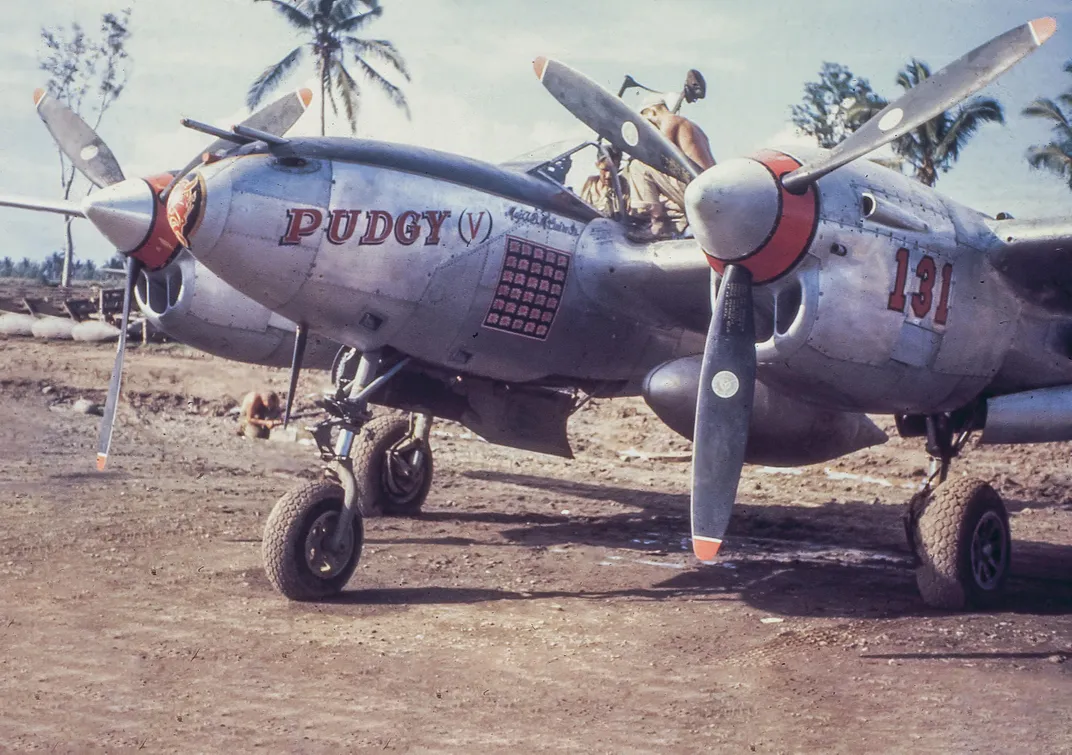
For the Fifth Air Force, November 2, 1944 passed in a nightmarish blur. Pilots from five different squadrons jammed onto Tacloban’s one useable runway to take off and land while the Japanese continued their hit-and-run raids. Part of the 475th Fighter Group arrived to add to the confusion, temporarily staying at Tacloban before moving on to the Dulag area’s soggy airfields. A Japanese resupply convoy steamed into Ormoc Bay, covered by almost a hundred Japanese fighters. Fights raged over the convoy and spilled all over Leyte as the Japanese launched multiple raids against Tacloban and the shipping nearby.
The days passed in a kaleidoscope of wrenching moments and furious combats over Tacloban and Ormoc Bay, where the Japanese kept running resupply convoys down to their troops defending northern Leyte. The weather grew worse. The other fields around Dulag were near busts. They couldn’t be drained properly, and the runways flooded every time a monsoon swept over the island.
Still, Kenney pushed the 475th Fighter Group forward, and for the next week, its airplanes and pilots streamed into Leyte.
On November 3, Bong, McGuire, and Lieutenant Colonel Gerald Johnson flew over to Ormoc, looking for trouble. Word was another convoy had landed supplies. They saw no ships, but they did discover a 10-mile-long vehicle convoy stretching out of Ormoc, heading toward Carigara Bay.
The squadron rolled in on the column, and caught a line of trucks trapped on the road by swamps on either side. The pilots raked them mercilessly even as soldiers bailed out of the rigs and tried to find cover. McGuire made a pass, and saw his cannon shells hit a couple of vehicles. They blew up, throwing bodies high in the air.
The squadron came back around, this time flying right on the trees as they strafed. Desperate Japanese fired rifles and light machine guns at them, using wrecked trucks and caissons as firing positions. Hundreds of men lay dead and splayed around the scene. Most of the pilots were nearly out of ammunition, so they reformed above the burning column. They’d destroyed 30 trucks and two light tanks. Later intelligence reports credited the squadron with killing or wounding 2,400 men, almost an entire infantry regiment.
Before the P-38s could clear the area, two Hayabusas suddenly sped through their formation, spewing tracers. As the pilots scattered to evade the Ki-43s, pilot Bob Bates was hit in the surprise attack. His burning P-38 arrowed into the jungle below. The rest of the squadron ran for home and landed back at Tacloban.
When they landed, McGuire realized he had been sitting in a pool of blood. During one of his strafing runs, a rifle-caliber bullet punctured the side of the cockpit and grazed his buttocks. He told no one of his wound, fearing he’d be pulled off flight status at a time when Japanese targets were plentiful. He had 25 kills, 10 behind Bong.
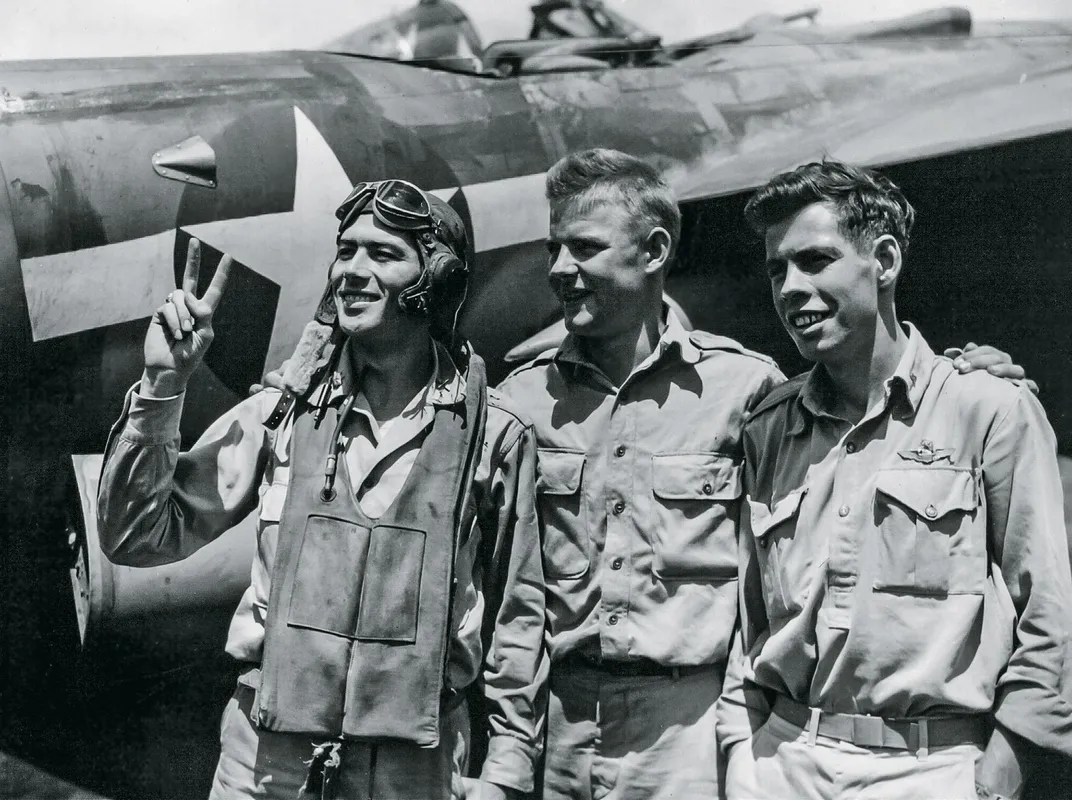
On November 10, 1944, McGuire flew on a mission over Ormoc Bay, where he blew up a Ki‑43 Hayabusa. A chunk of the Ki-43 smashed through McGuire’s canopy hatch and struck him in the head, knocking him unconscious for a few seconds. When he came to, blood covered his head and face.
McGuire was dazed but not seriously hurt. In fact, he was feeling better than he had in a long time. He’d just tied Eddie Rickenbacker’s World War I record. He wanted to savor the moment. When his crew chief suggested he go see a doctor, McGuire blew him off saying, “Let’s keep this quiet. I don’t want to lay around while the hunting is so good.”
That afternoon, Bong shot down another airplane. Every time McGuire thought he’d closed the gap between them, Bong would match him, kill for kill. It was maddening, and McGuire started to fixate on the race of aces.
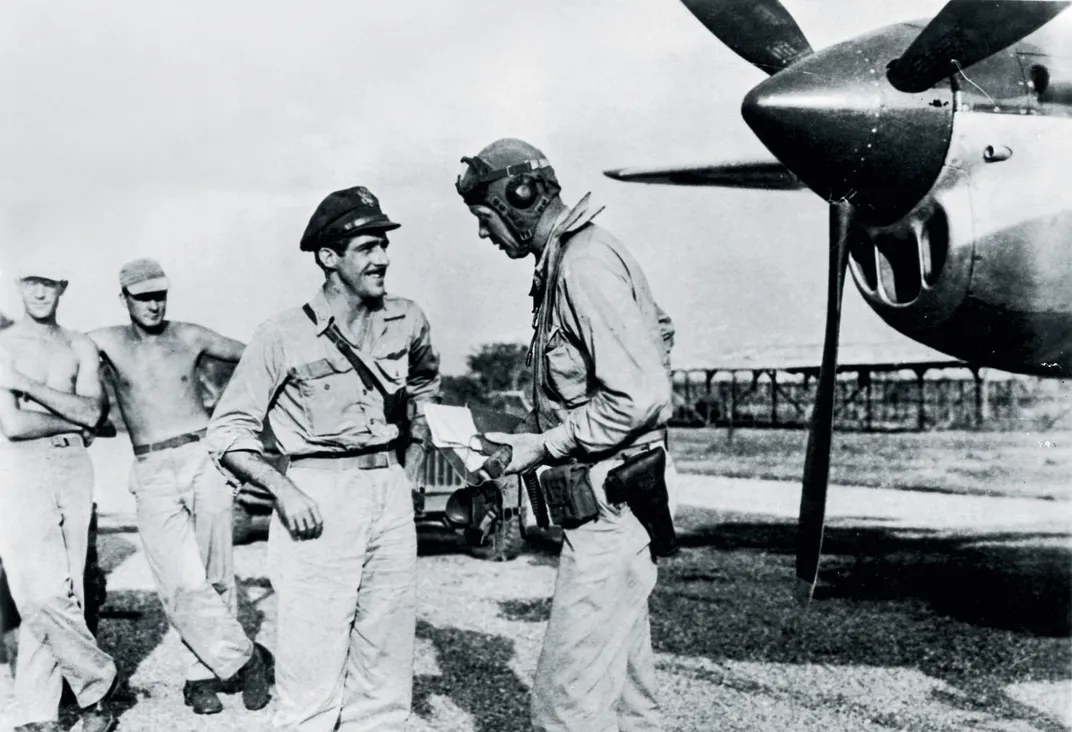
As the race reached a fevered peak, so did the air war over Leyte. On December 7, 1944, the Japanese and Americans both ran convoys into Ormoc Bay. The Japanese were trying to supply their troops. The Americans came to cut that supply point off, landing the 77th Infantry Division at Ormoc to seal off the port from the Japanese and to get behind their lines in force. McGuire and Bong flew together on a midafternoon patrol over Ormoc. McGuire led the flight, and Bong took the second element with Major Jack Rittmayer as his wingman. As they reached Ormoc, Bong’s sharp eyes made out a Japanese Mitsubishi Ki-21 bomber running along some clouds. Without calling it out, he suddenly broke formation, charged after the aircraft, and sent it down in flames. McGuire and his wingman seethed over Bong’s behavior.
Bong had violated the most basic and inviolable law of air combat in the Pacific Theater: teamwork. He’d abandoned his formation, failed to communicate, and went off hunting. This was a serious breach, one that in the past got Americans killed. Teamwork, the integrity of the formations, and fighting together had been drilled into every pilot coming into the Southwest Pacific theater since 1943. A month before, an 8th Fighter Squadron pilot had abandoned his flight to go shoot down two Zeros, and instead of collecting accolades, his actions were written up in a combat report slamming the pilot’s behavior.
Bong’s actions that day alienated much of the squadron. They considered him selfish, only there to score, and obsessed with staying ahead of McGuire.
All this drama was kept out of the public eye. It was soon overwhelmed with a tidal wave of new media coverage of the Wisconsin ace. The next day the press broke the news that Richard Ira Bong, America’s ace of aces with 39 kills, not only just surpassed Britain’s top ace Johnnie Johnson, but had been awarded the Medal of Honor as well. Four days later, as rain fell at Tacloban, the men of the 475th and 49th Fighter Groups stood at formation as General Douglas MacArthur gave the award to Bong.
MacArthur was at his rhetorical best as he addressed his weary, wet aviators. “The Congress of the United States has reserved for itself the honor of decorating those amongst all who stand out as the bravest of the brave. It is this high and noble category, Major Bong, that you now enter as I place upon your breast the Medal of Honor. Wear it as the symbol of invincible courage you have displayed in mortal combat. My dear boy, may a merciful God continue to protect you.”
Ten days later, Bong flew one final combat mission with the 431st Fighter Group, shooting down a Japanese fighter over Mindoro Island. He’d reached 40, earned the Medal of Honor, and now stood two kills over Britain’s Johnnie Johnson. He also outscored the U.S. Navy’s ranking ace, David McCampbell, whose kill board included 34 Japanese flags. Enough was enough. Bong would never return to battle.
But McGuire had 38 kills. Maybe the race wasn’t over after all.
/https://tf-cmsv2-smithsonianmag-media.s3.amazonaws.com/filer/6a/e5/6ae5cccf-9b20-4408-942a-2d61dcd10437/vertical.jpg)
As Bong made his way home across the Pacific to San Francisco, McGuire was grounded by Kenney. He couldn’t send Bong back to the States as the top ace only to have the crown snatched from his head by McGuire.
McGuire ignored his commanding general’s orders and surreptitiously flew several fighter sweeps. He was close to beating Bong’s record, and wanted those three kills. His fixation on them skewed his decision-making.
Though everyone in the squadron knew he’d been put on the bench, they looked the other way as he climbed into his aircraft and went hunting. Should he shoot anyone down, he’d just hold back the news until after Bong was properly adulated back home.
McGuire flew three combat missions on December 30, 31, and January 2. Kenney apparently never found out about them. Bong landed in San Francisco on New Year’s Eve and started the publicity victory lap expected of America’s greatest air hero.
A few days later, Kenney lifted his grounding order, but McGuire knew he would be rotated home soon as well. He needed a sure thing.
On the evening of January 6, in a tent full of fighter pilots, the drinks flowed and the chatter became informal. The typical banter changed when somebody said, “So, Mac, what are we going to do to get you three?”
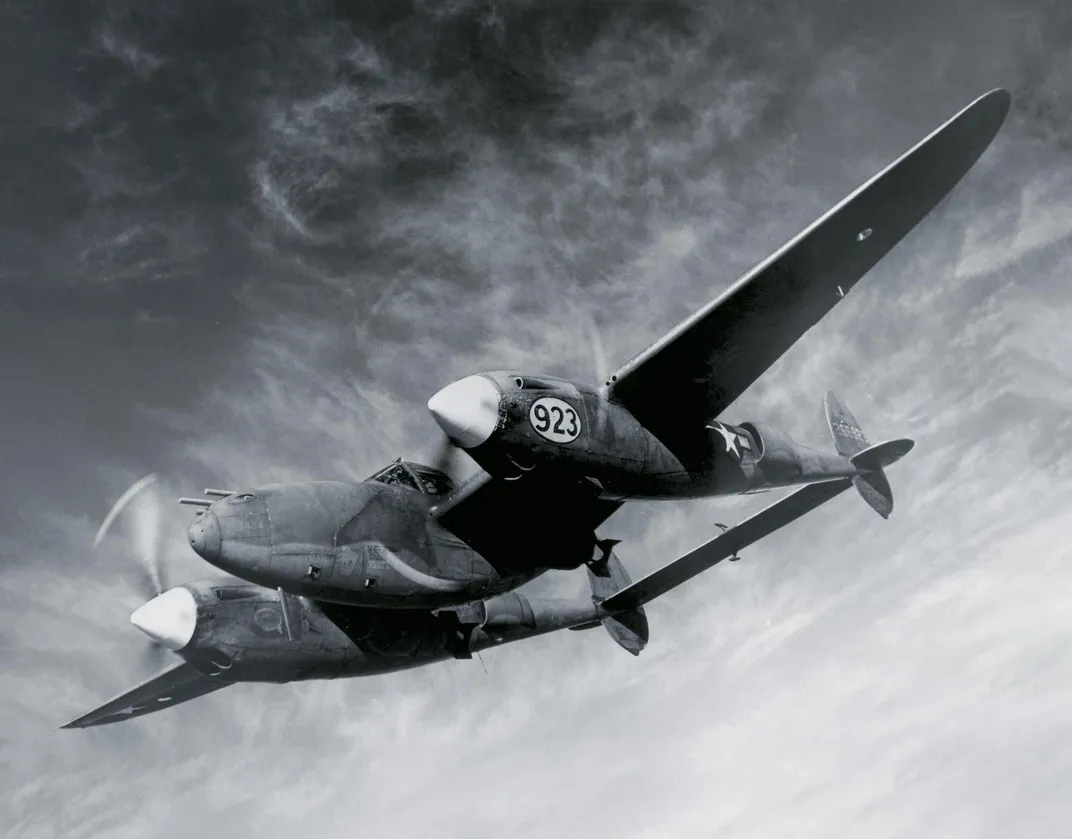
A lengthy discussion ensued. Where were the Japanese? They used to be everywhere from Mindanao in the south, and scattered around the central islands and Luzon. But over the past week, hardly anyone had seen an airplane. January 4 was the last time the squadron had scored—a single Japanese fighter downed north of Manila.
Somebody mentioned that the Japanese were sending warships down to Mindoro to shell the beachhead there. It was pure scuttlebutt, but the idea of going up there to find a Japanese task force took hold. McGuire left the tent to go secure the aircraft and make sure they were prepped with drop tanks before first light. He never got permission for the flight from Command. This was going to be strictly off the books.
On January 7, 1945, McGuire and his volunteers rose just before dawn; four P-38s awaited, each with a pair of 150-gallon tanks slung under the wings between the fuselage and engine nacelles. They’d need extra gas to get to Mindoro and back, but the tanks had proven to be a major problem with the new P-38Ls. Not only did they sometimes refuse to come off the shackles, but now their tails often sliced through the dive flaps when released.
Other times, the drop tanks stuck to the fuel standpipe, twisted in the slipstream and tore open the engine nacelles or fuselage. The ground crews took to smearing castor oil on the standpipes, hoping that would help the tanks slip clear. It offered only marginal improvement.
They took off from Dulag at 0620, McGuire in the lead, with Lieutenant Ed Weaver on his right wing. Major Jack Rittmayer took up station behind the lead element and offset to the left, with Lieutenant Douglas Thropp off his left wing.
Radio silent, they climbed to 10,000 feet, heading west to cross over northern Negros Island before turning north to Mindoro. The Japanese had several airdromes on Negros that were used as staging bases for missions against Leyte. McGuire intended to check them out first to see if they could find any aircraft.
A half hour after takeoff, they ran into bad weather. Weaver’s voice broke through the silence.
“Zero! Twelve o’clock low. Coming straight at us.”
It wasn’t a Zero, but a late-model Hayabusa flown by Sergeant Akira Sugimoto, an extremely experienced, high-time Ki-43 pilot who was returning to Fabrica Airdrome after conducting a search for a reported American naval convoy.
The setup was so close, barely anyone had time to react. Sugimoto started the fight a thousand feet ahead of the lead P-38s, converging at perhaps 520 feet per second. McGuire and Weaver had two seconds to react, nowhere near the time needed to prep a P-38 for combat.
The Ki-43 sped straight underneath the lead P-38s, Sugimoto possibly unaware of their presence. At the same instant they merged, McGuire horsed his P-38 into a tight left turn. Committed to a turn, McGuire couldn’t release his fuel tanks. He entered the dogfight with almost 2,000 pounds of extra weight under his P-38. This radically changed the turn rate, speed, and stall characteristics of the Lightning.
Thropp turned left and started to climb. This was McGuire’s show, and the whole point was to get him kills. Sugimoto rolled right, stood his Oscar on its wing, and bent around after Thropp. He closed quickly.
Where was McGuire? He should have been able to roll out of his left turn and get right in behind this Oscar. But he remained in a tight left bank.
Rittmayer saved Thropp’s life, firing as he approached from behind and to the left of Sugimoto, who pulled off Thropp, and whipped around and went straight for Weaver.
McGuire saw Weaver’s predicament. Thropp couldn’t help. Rittmayer was out of position. They were at 200 feet, so Weaver couldn’t dive away. McGuire was his only chance.
McGuire tucked the yoke in tighter, trying to pull the P-38 around to get a shot on the Oscar. The nose shuddered; suddenly the P-38 snap-rolled. The nose dropped. McGuire ended up inverted for a split second, then his fighter plunged straight into the ground and exploded.
The race of aces was over.
Excerpted from Race of Aces: WWII’s Elite Airmen and the Epic Battle to Become the Master of the Sky by John R. Bruning. Copyright © 2020. Available from Hachette Books, an imprint of Hachette Book Group, Inc.
A Note to our Readers
Smithsonian magazine participates in affiliate link advertising programs. If you purchase an item through these links, we receive a commission.
